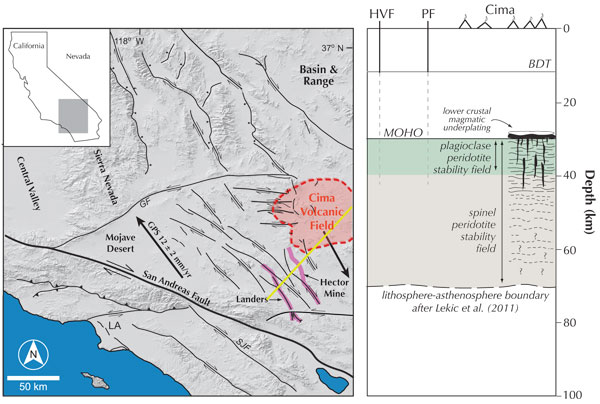Rheological properties of the mantle lid beneath the Mojave region
By:
Whitney M. Behr
University of Texas at Austin, Department of Geological Sciences
| When: | Friday, October 4, 2013 10:30 a.m. to 11:30 a.m. Join us for coffee beginning at 10:00 a.m. |
| Where: | Seminar Conference Room 10100 Burnet Road Bldg 196-ROC Austin, Texas 78758 |
| Host: | Nick Hayman, UTIG |
Click for a Live Broadcast.
Right: [A] Regional fault map of the Mojave block, modified from Frankel et al. [2007]. The Landers (1992) and Hector Mine (1999) earthquake ruptures are shown in pink. Yellow line shows the location of the schematic cross-section in [B]. [B] Schematic cross-section through the Cima field based on petrological description of the Cima xenoliths from Wilshire [1990], and Cardon [2009]; depth of the Moho from McCarthy and Thompson [1988] and Wilshire [1990]; and depth of the LAB from Lekic et al. [2011].
Abstract
Recently deformed mantle peridotite xenoliths derived from Moho depths constrain the geothermal gradient, stress magnitude, viscosity, and degree of localization in the upper mantle within the tectonically active Mojave region of California. Microstructural observations and water content measurements in the xenoliths indicate that upper mantle deformation is accommodated by dislocation creep of olivine with ~250 ppm H/Si.
Differential stresses measured using olivine paleopiezometry are 12-15 MPa, several tens to hundreds of MPa less than stresses estimated for the gabbroic lower crust and the brittle upper crust.
Similarly, a calculated mean viscosity of 5 x 1019 Pa-s for the uppermost mantle is approximately two orders of magnitude less than estimated for the lower crust, consistent with recent models of the Mojave region based on postseismic relaxation following the Landers (1992) and Hector Mine (1999) earthquakes. These results confirm that the Mojave region fits a `creme brulee' model of lithospheric rheology structure, in which the peak stress resides in the crust, rather than within the lithospheric mantle. Temperatures and pressures recorded in the xenoliths indicate a high geothermal gradient of at least 825°C at the Moho, which may explain the regional weakness of the mantle lid. Strain rates calculated for the uppermost mantle using the xenolith data and olivine flow laws for wet dislocation creep, are at least four times higher than bulk strain rates estimated across the central Mojave region from GPS-constrained surface velocities. This implies either that faults at the eastern border of the Eastern California Shear Zone persist through the seismogenic zone and retain their identities as narrow ductile shear zones into the mantle beneath the Moho; or alternatively, that a zone of high strain just below the Moho accommodates differential motion of upper and lower lithospheric layers.





